Wavelet Analysis of the Similarity in the Inflation Index (HICP) Dynamics for Electricity, Gas, and Other Fuels in Poland and Selected European Countries
Abstract
1. Introduction
2. Literature Review
3. Methods and Data
3.1. Wavelets, Cross-Wavelet Transform, and Wavelet Coherence
3.2. Interpretation of Wavelet Coherence Plots
- Wavelet coherence magnitude: In the coherence plots, the colour indicates the strength of the relationship between the two series (as per the scale labelled “Magnitude-Squared Coherence”). Yellow-orange areas denote high coherence (values close to 1), meaning strong synchronisation between Poland and the given country at those frequencies and times. Blue areas denote low coherence, suggesting a weak relationship or no relationship at those frequencies/times.
- Time and period axes: The vertical axis shows the period (in months) corresponding to the oscillations, allowing us to distinguish short-term cycles (approximately 2–6 months), medium-term cycles (6–24 months), and long-term cycles (24 months or more). The horizontal axis shows the time, covering January 2001 to December 2024.
- Phase arrows: The arrows on the coherence plots indicate the phase difference between the two series (Poland = series X, the other country = series Y). The direction of the arrows conveys the leading–lagging relationship and whether the movements are in phase or anti-phase. Specifically, they mean the following:
- –
- Rightward arrow (→): X and Y are in phase (move together).
- –
- Leftward arrow (←): X and Y are in anti-phase (when one increases, the other decreases).
- –
- Arrow pointing up or down (↑ or ↓): A 90° phase difference, meaning that one series leads the other by a quarter cycle (↑ means that Y leads X by 90°; ↓ means that X leads Y by 90°).
- –
- Arrow pointing northeast (↗): Y leads X, and the changes are in the same direction (i.e., Y is ahead of X, with both trending similarly).
- –
- Arrow pointing southeast (↘): X leads Y, with changes in the same direction.
- –
- Arrow pointing northwest (↖): Y leads X, with changes in opposite directions.
- –
- Arrow pointing southwest (↙): X leads Y, with changes in opposite directions.
- RQ1:
- When—during which sub-periods and at which periodicities (short-, medium-, or long-term)—did strong relationships exist between Poland’s energy inflation and another country’s energy inflation? In other words, we identified the time intervals and frequency ranges where the wavelet coherence was high.
- RQ2:
- What was the temporal ordering of movements between Poland and the other country—did one lead or lag the other, and if so, which one? This pertained to the phase difference: if significant coherence was found, we determined whether Poland’s series was leading or lagging.
4. Results
4.1. Significant Wavelet Coherence
4.1.1. Countries Leading Energy Inflation in Poland (Potential Barometers)
4.1.2. Countries Lagging Behind Poland in Regard to Energy Inflation (Reactive Countries)
4.2. Crisis Sub-Periods and Price Dynamics Analysis
- Financial crisis (2008–2012): During this period, Poland’s energy inflation dynamics showed the strongest similarities with Central and Eastern European (CEE) countries such as Czechia (Figure A2c), Slovakia (Figure A4d), and Hungary (Figure A2b). Notably, there was also strong coherence with Germany (Figure A1d) and Lithuania (Figure A1f) in this sub-period. This suggests that the financial crisis triggered a regionally synchronised response in energy prices, linking Poland with its regional neighbours in particular and major EU economies like Germany.
- COVID-19 pandemic (2020–2021): In this sub-period, Poland’s energy inflation showed convergence in its dynamics with countries like Germany (Figure A1d), the Netherlands (Figure A2e), and France (Figure A4f). In contrast, some southern European countries, specifically Spain (Figure A4c) and Greece (Figure A5b), experienced much lower energy inflation dynamics. In other words, Poland’s pattern was more closely aligned with that of the core EU countries, whereas parts of southern Europe were somewhat insulated from or experiencing a delay in this particular shock, possibly due to different energy mixes or policy responses during the pandemic.
- Energy crisis (2022–2024): This period, encompassing the fallout from the war in Ukraine and the resulting energy shortages and price spikes, saw very high synchronisation across nearly the entire EU (Figure A1b). Poland’s energy inflation was especially strongly coherent with that of Germany (Figure A1d), Czechia (Figure A2c), Estonia (Figure A3b), and Slovakia (Figure A4d) during this time. Essentially, the shock was Europe-wide, and Poland’s experience was closely mirrored in both neighbouring countries and some more distant ones.
4.3. Country Groupings and Links to Energy Mix
- –
- Group A—Leading countries with high coherence: This group includes Germany, Czechia, Lithuania, Hungary, and Romania. These countries are highly correlated with Poland’s energy price index and often lead Poland (as identified in Section 4.1.1). Energy mix characteristics: They have a high dependence on natural gas and similar supply conditions (many are Central and Eastern European countries with comparable energy infrastructure and dependencies).
- –
- Group B—Lagging countries with medium coherence: This group consists of Bulgaria, Croatia, Spain, and Portugal. They show a moderate degree of coherence with Poland but generally lag behind Poland’s changes (as described in Section 4.1.2). Energy mix characteristics: These countries have a higher share of renewable energy sources (RESs) and lower dependence on Russian gas supplies, which might have buffered or delayed the transmission of shocks that strongly hit Poland.
- –
- Group C—Synchronous during crises, but have a low long-term correlation: This group includes Greece, Ireland, Cyprus, and Norway. They tend to align with Poland during major crises (showing coherence spikes during those periods) but have a lower correlation with Poland in the long run. Energy mix characteristics: They rely heavily on either renewable or domestic energy resources. For example, Norway’s energy prices are dominated by hydropower (and it is not in the EU), which gives it a distinct profile, and Ireland and Cyprus also have unique energy supply situations (island nations with specific energy policies).
- –
- Group D—Stabilising countries with varied responses: This includes France, Austria, and Finland. These countries have somewhat varied responses that do not always move in sync with those of Poland and sometimes act to stabilise the regional price dynamics. Energy mix characteristics: They have a high share of nuclear power (especially France and to some extent Finland) and/or significant regulated (administered) pricing in their energy markets. These factors tend to dampen price volatility and can decouple their inflation dynamics from market-driven shocks that affect Poland.
4.4. Poland’s Energy Prices and Administered Price Controls
- –
- Administrative price setting: Regulated tariffs set by the Energy Regulatory Office (URE) can delay the pass-through of market price changes to consumers.
- –
- Subsidisation of energy costs during crises: For instance, in 2022–2023 the government intervened heavily (subsidies, tax reductions, price caps) to shield consumers from the full brunt of the energy crisis.
- –
- Energy mix dependency: Poland’s heavy reliance on coal in its energy mix means that domestic production can buffer short-term shocks, but also that adjustments (when they come) may be abrupt if coal prices or policy subsidies change.
5. Discussion
6. Conclusions
- They are reactive but temporally aligned with the CEE region: Poland often lags behind certain Central and Eastern European (CEE) countries in regard to energy inflation, yet moves broadly in sync with regional trends;
- They are highly dependent on administered price policies: Domestic regulations (such as price controls and subsidies) play a significant role in Poland’s inflation dynamics, sometimes delaying or dampening the effect of global price shocks;
- They show significant coherence during crises with key countries (notably Germany, Czechia, Slovakia, and Hungary): During major energy crises, Poland’s inflation rates moved closely with these countries, reflecting shared shocks and, possibly, coordinated responses.
Author Contributions
Funding
Data Availability Statement
Conflicts of Interest
Appendix A
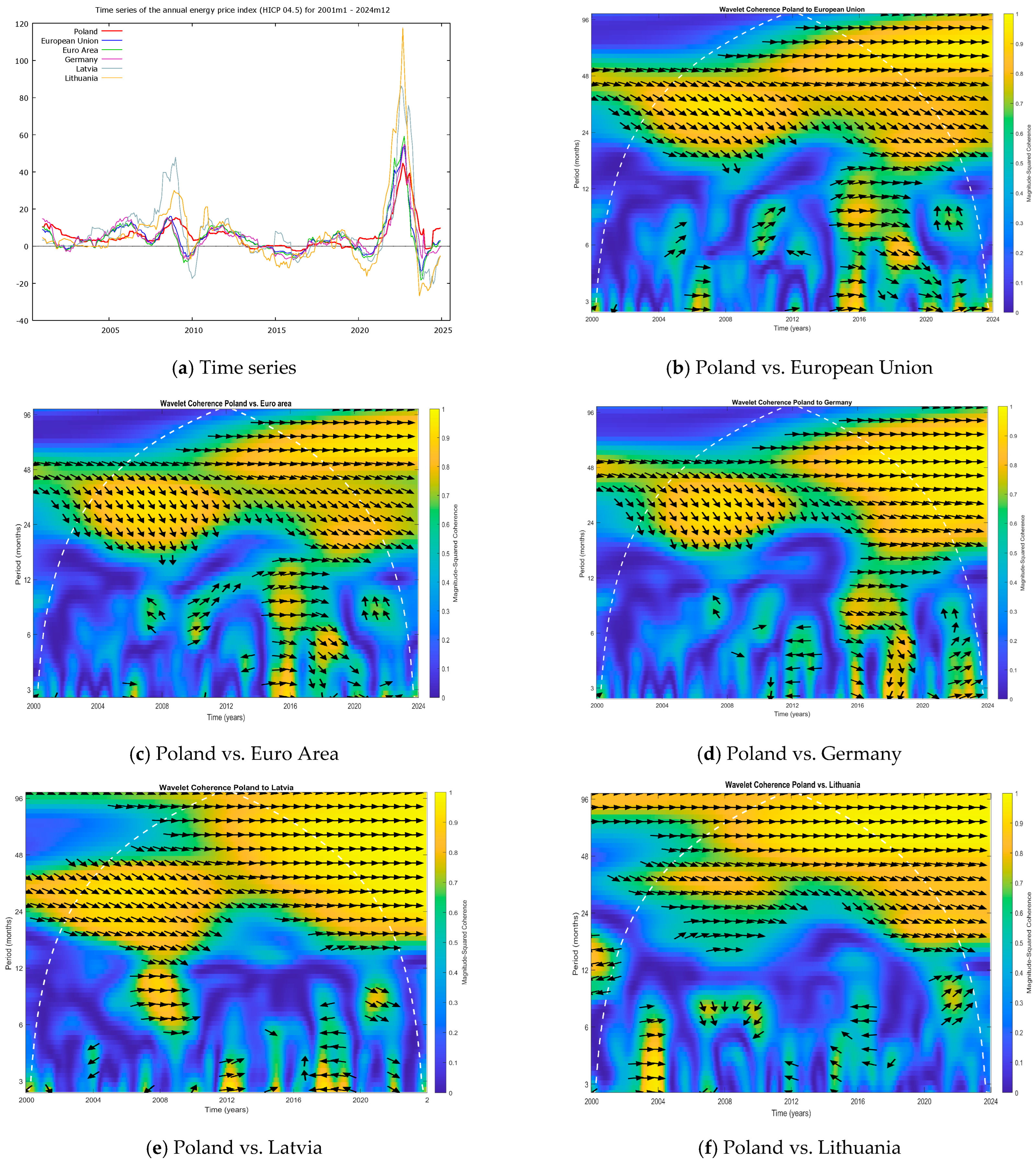
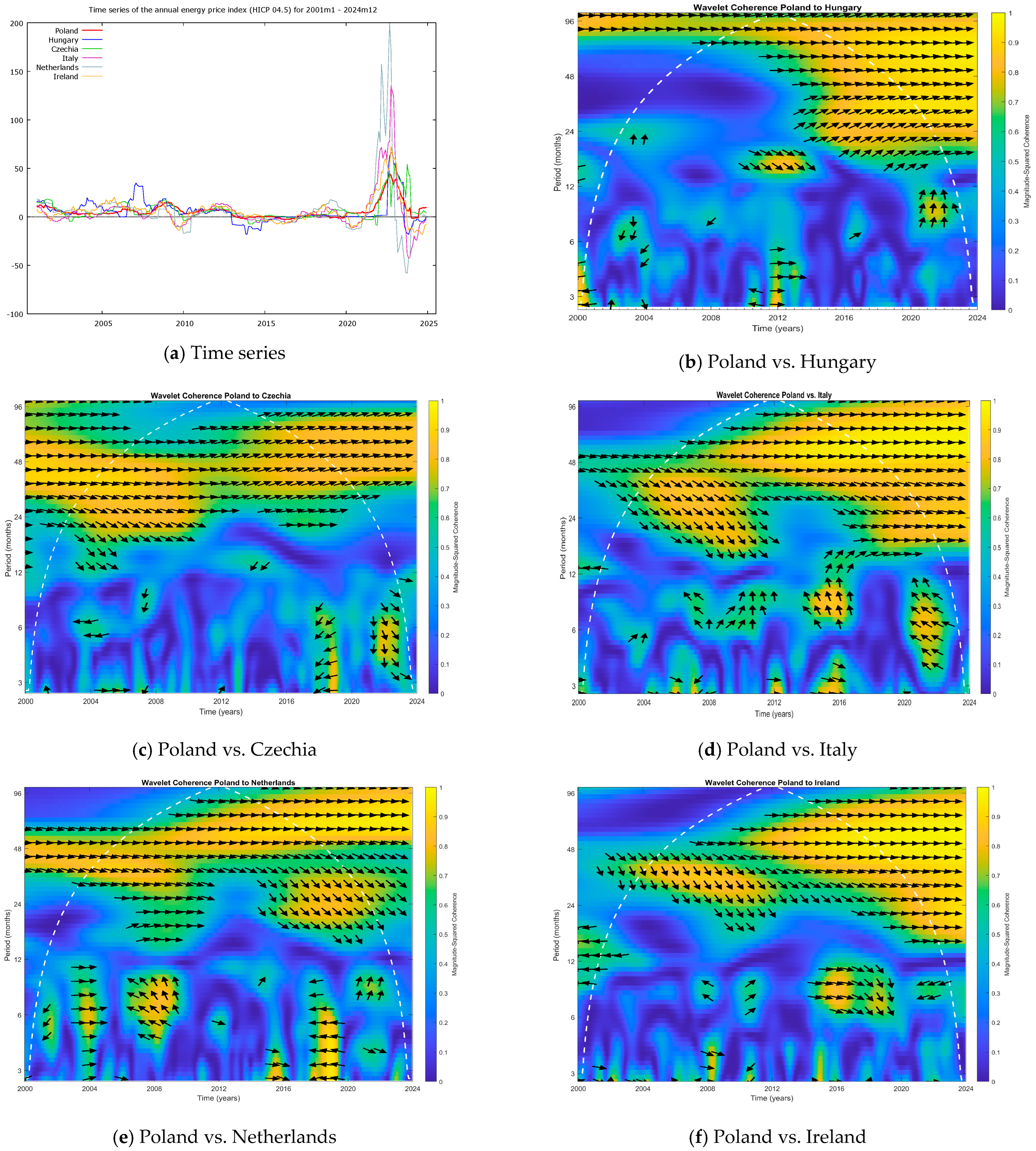
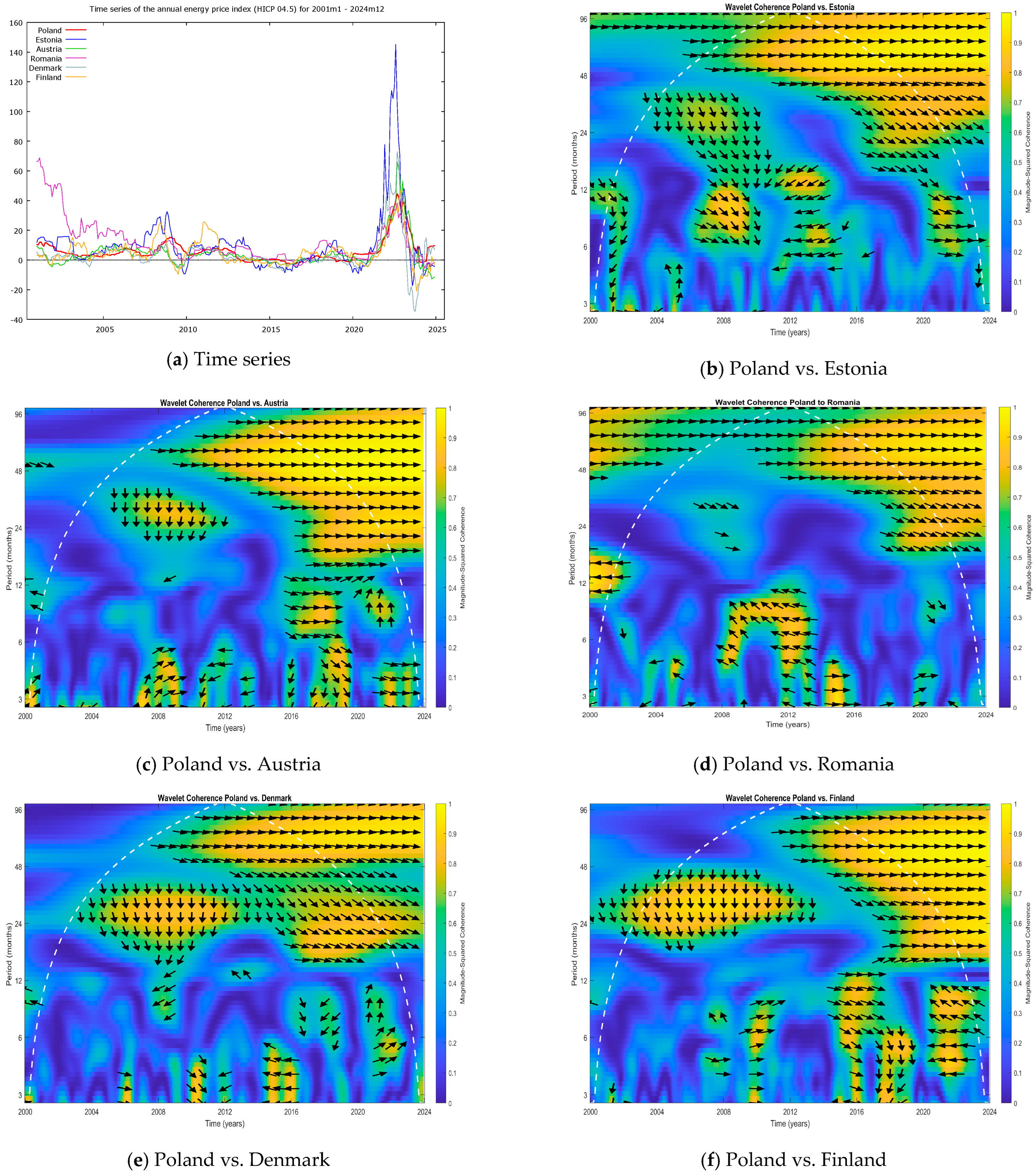
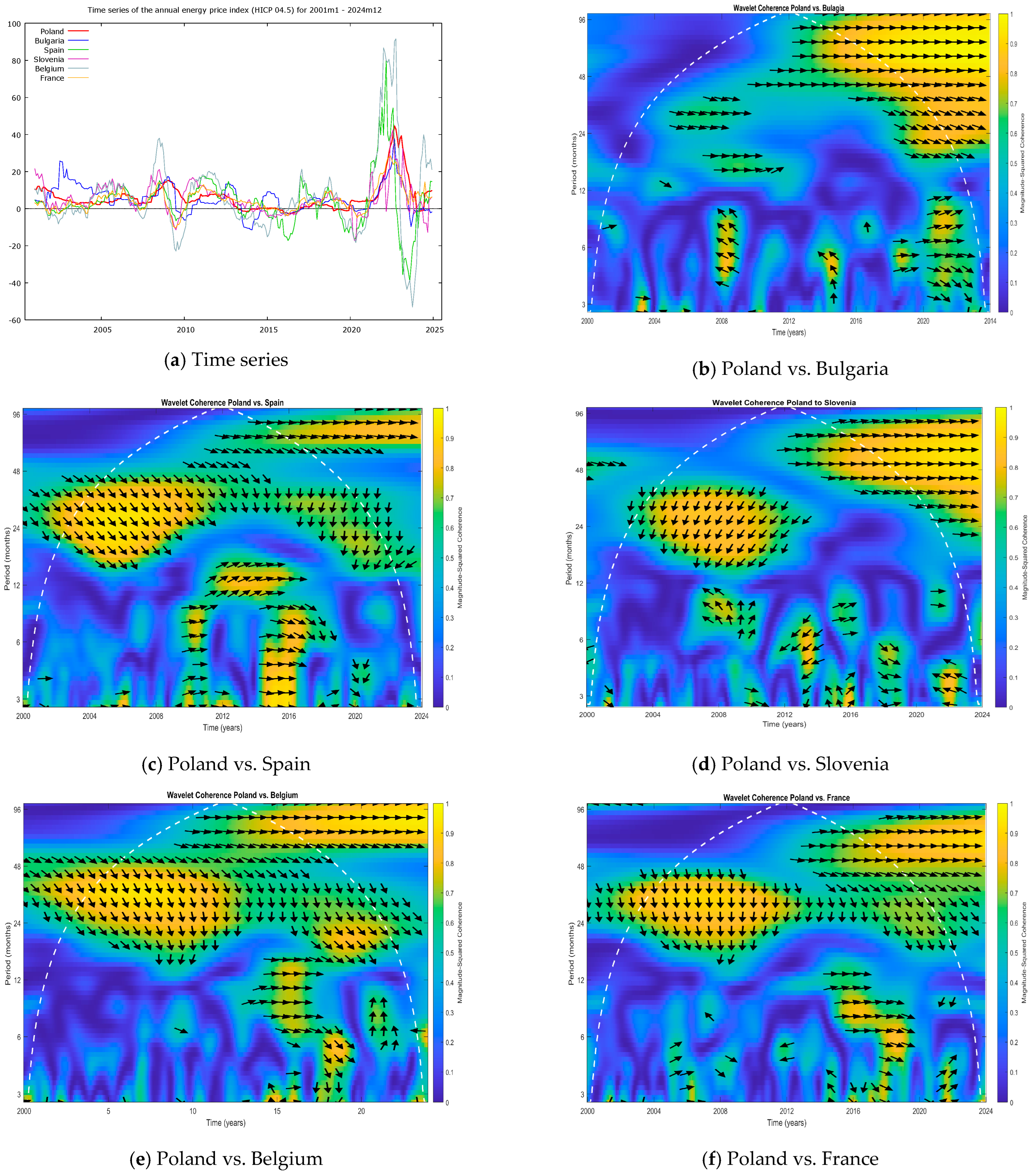

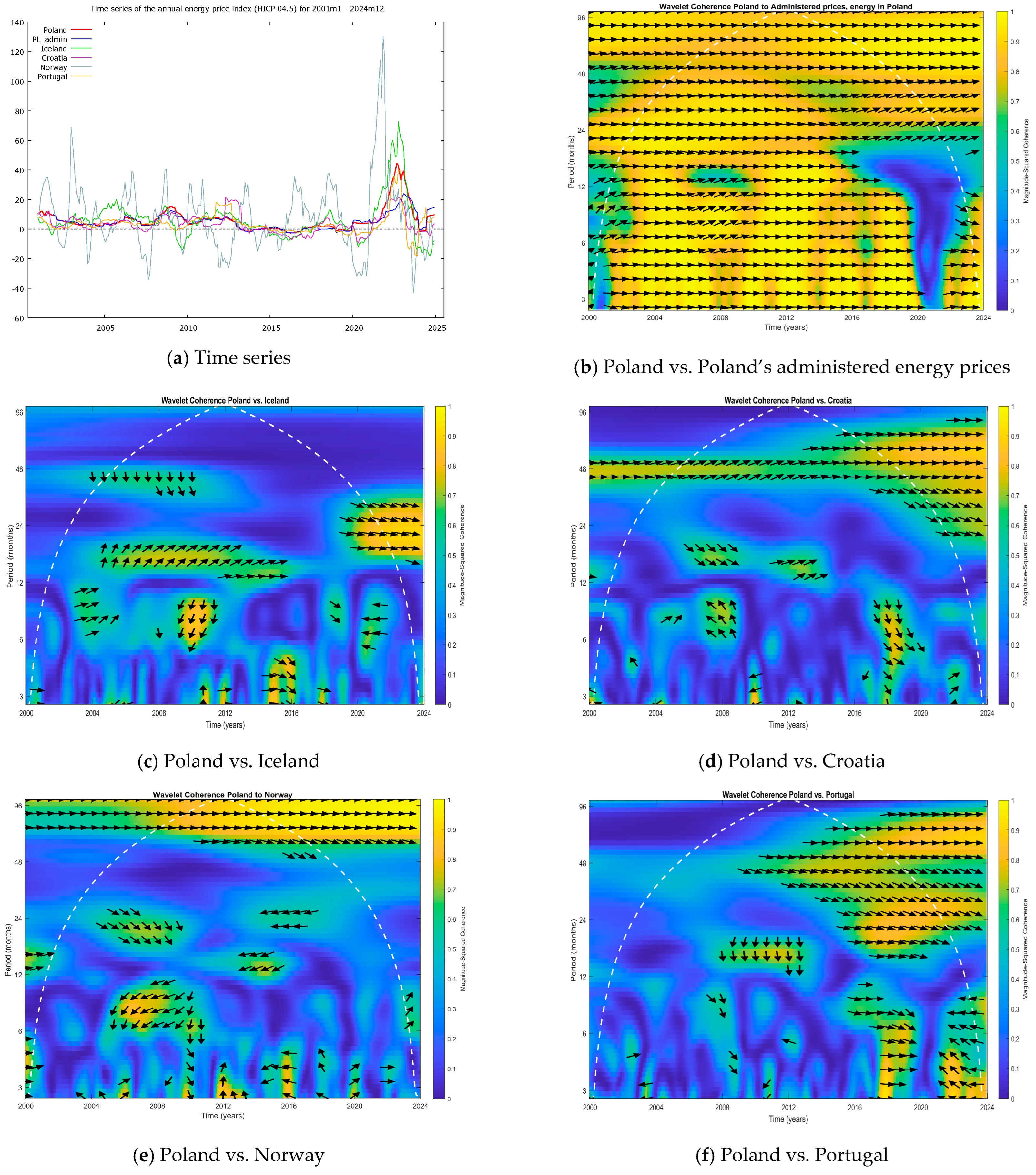
References
- Raczkowski, K.; Komorowski, P. International Economic Policy for the Polycrisis; Routledge: London, UK, 2024. [Google Scholar] [CrossRef]
- Bátora, J.; Fossum, J.E. Differentiation and Dominance in Europe’s Poly-Crises; Routledge: London, UK, 2024. [Google Scholar] [CrossRef]
- Korzeb, Z.; Niedziółka, P.; Liuhto, K.; Bryc, A.; Niedziółka, D.; Mróz, M. Fossil Fuels in the European Union; Springer: Cham, Switzerland, 2024; Volume 99. [Google Scholar] [CrossRef]
- Jonek-Kowalska, I. Assessing the energy security of European countries in the resource and economic context. Oeconomia Copernic. 2022, 13, 301–334. [Google Scholar] [CrossRef]
- Pereira, F.; Aguiar-Conraria, L. Eurozone Inflation Convergence: Deceptive Appearances. Struct. Change Econ. Dyn. 2025, 74, 343–352. [Google Scholar] [CrossRef]
- Binder, C.C. Inflation expectations and the price at the pump. J. Macroecon 2018, 58, 1–18. [Google Scholar] [CrossRef]
- Kilian, L.; Zhou, X. Oil prices, gasoline prices, and inflation expectations. J. Appl. Econom. 2022, 37, 867–881. [Google Scholar] [CrossRef]
- Liu, N.; Xu, Z.; Skare, M. The research on COVID-19 and economy from 2019 to 2020: Analysis from the perspective of bibliometrics. Oeconomia Copernic. 2021, 12, 217–268. [Google Scholar] [CrossRef]
- Nicola, M.; Alsafi, Z.; Sohrabi, C.; Kerwan, A.; Al-Jabir, A.; Iosifidis, C.; Agha, M.; Agha, R. The socio-economic implications of the coronavirus pandemic (COVID-19): A review. Int. J. Surg. 2020, 78, 185–193. [Google Scholar] [CrossRef] [PubMed]
- Tiwari, A.K. Oil prices and the macroeconomy reconsideration for Germany: Using continuous wavelet. Econ. Model 2013, 30, 636–642. [Google Scholar] [CrossRef]
- Pietrzak, M.B.; Olczyk, M.; Kuc-Czarnecka, M.E. Assessment of the Feasibility of Energy Transformation Processes in European Union Member States. Energies 2022, 15, 661. [Google Scholar] [CrossRef]
- Pietrzak, M.; Igliński, B.; Kujawski, W.; Iwański, P. Energy Transition in Poland—Assessment of the Renewable Energy Sector. Energies 2021, 14, 2046. [Google Scholar] [CrossRef]
- Marín-Rodríguez, N.J.; González-Ruiz, J.D.; Botero, S.B. Dynamic Co-Movements among Oil Prices and Financial Assets: A Scientometric Analysis. Sustainability 2022, 14, 12796. [Google Scholar] [CrossRef]
- Jędruchniewicz, A. Fulfillment of the Inflation Target in Poland. Oeconomia Copernic. 2013, 4, 5–21. [Google Scholar] [CrossRef][Green Version]
- Farid, S.; Karim, S.; Naeem, M.A.; Nepal, R.; Jamasb, T. Co-movement between dirty and clean energy: A time-frequency perspective. Energy Econ. 2023, 119, 106565. [Google Scholar] [CrossRef]
- Ainou, F.Z.; Ali, M.; Sadiq, M. Green energy security assessment in Morocco: Green finance as a step toward sustainable energy transition. Environ. Sci. Pollut. Res. 2022, 30, 61411–61429. [Google Scholar] [CrossRef]
- Zheng, M.; Feng, G.-F.; Chang, C.-P. Is green finance capable of promoting renewable energy technology? Empirical investigation for 64 economies worldwide. Oeconomia Copernic. 2023, 14, 483–510. [Google Scholar] [CrossRef]
- Wang, X.; Xu, Z.; Wang, X.; Skare, M. A review of inflation from 1906 to 2022: A comprehensive analysis of inflation studies from a global perspective. Oeconomia Copernic. 2022, 13, 595–631. [Google Scholar] [CrossRef]
- Tiwari, A.K.; Cunado, J.; Gupta, R.; Wohar, M.E. Are stock returns an inflation hedge for the UK? Evidence from a wavelet analysis using over three centuries of data. Stud. Nonlinear Dyn. Econom. 2019, 23, 20170049. [Google Scholar] [CrossRef]
- Tiwari, A.K.; Cunado, J.; Hatemi-J, A.; Gupta, R. Oil price-inflation pass-through in the United States over 1871 to 2018: A wavelet coherency analysis. Struct. Change Econ. Dyn. 2019, 50, 51–55. [Google Scholar] [CrossRef]
- Wang, Y. Defense Budget Growth and Inflation: A Wavelet-Based Study of the U.S. and Britain. Political Stud. Rev. 2023, 21, 260–284. [Google Scholar] [CrossRef]
- Zaremba, A.; Umar, Z.; Mikutowski, M. Inflation hedging with commodities: A wavelet analysis of seven centuries worth of data. Econ. Lett. 2019, 181, 90–94. [Google Scholar] [CrossRef]
- Kim, S.; In, F. The relationship between stock returns and inflation: New evidence from wavelet analysis. J. Empir. Financ. 2005, 12, 435–444. [Google Scholar] [CrossRef]
- da Conceição, G.F.D. The impact of energy prices on inflation and economic growth in Mozambique: A wavelet approach and OLS estimator. South Afr. J. Econ. 2024, 92, 354–385. [Google Scholar] [CrossRef]
- Tarkun, S. Dynamic relationships between inflation, industrial production, and freight rates in the EU: A wavelet coherence and causality analysis. Mar Policy 2025, 172, 106534. [Google Scholar] [CrossRef]
- Magazzino, C.; Giolli, L. Analyzing the relationship between oil prices and renewable energy sources in Italy during the first COVID-19 wave through quantile and wavelet analyses. Renew. Energy Focus 2024, 48, 100544. [Google Scholar] [CrossRef]
- Rua, A.; Nunes, L.C. International comovement of stock market returns: A wavelet analysis. J. Empir. Financ. 2009, 16, 632–639. [Google Scholar] [CrossRef]
- Lin, C.H. The comovement between exchange rates and stock prices in the Asian emerging markets. Int. Rev. Econ. Financ. 2012, 22, 161–172. [Google Scholar] [CrossRef]
- Adebayo, T.S. Dynamic Relationship between Oil Price and Inflation in Oil Exporting Economy: Empirical Evidence from Wavelet Coherence Technique. Energy Econ. Lett. 2020, 7, 12–22. [Google Scholar] [CrossRef]
- Tiwari, A.K.; Abakah, E.J.A.; Gil-Alana, L.A.; Abakah, M.K. Inflation Co-Movement Dynamics: A Cross-Country Investigation Using a Continuous Wavelet Approach. J. Risk Financ. Manag. 2021, 14, 613. [Google Scholar] [CrossRef]
- Ryczkowski, M. Money and inflation in inflation-targeting regimes—New evidence from time–frequency analysis. J. Appl. Econ. 2021, 24, 17–44. [Google Scholar] [CrossRef]
- Mutascu, M.; Strango, C.; Sokic, A. Demand for electric cars and oil prices: A wavelet approach. Int. J. Green Energy 2024, 21, 3498–3520. [Google Scholar] [CrossRef]
- Aladwani, J. Wavelet Coherence and Continuous Wavelet Transform—Implementation and Application to the Relationship between Exchange Rate and Oil Price for Importing and Exporting Countries. Int. J. Energy Econ. Policy 2023, 13, 531–541. [Google Scholar] [CrossRef]
- Hoong, L.Z.; Tsen, W.H.; Pinjaman, S.B.; Mansur, K. Co-Movement of COVID-19, The S&P 500 and Stock Markets in ASEAN: A Wavelet Coherence Analysis. 2022. Available online: http://www.ijem.upm.edu.my (accessed on 1 July 2025).
- Wijesekara, C.; Tittagalla, C.; Jayathilaka, A.; Ilukpotha, U.; Jayathilaka, R.; Jayasinghe, P. Tourism and economic growth: A global study on Granger causality and wavelet coherence. PLoS ONE 2022, 17, e0274386. [Google Scholar] [CrossRef] [PubMed]
- Tiwari, A.K.; Dar, A.B.; Bhanja, N. Oil price and exchange rates: A wavelet based analysis for India. Econ. Model 2013, 31, 414–422. [Google Scholar] [CrossRef]
- Razi, U.; Cheong, C.W.H.; Shams, S.; Sarker, T.; Sharif, A.; Afshan, S. Assessing the turbulence: Wavelet coherence and causality analysis of energy price volatility and exchange rate instability. Energy 2025, 331, 136948. [Google Scholar] [CrossRef]
- Wu, T.-P.; Wu, H.-C.; Wang, C.-M.; Wu, Y.-Y. Causality between tourism and housing prices: A wavelet-based approach. J. Policy Res. Tour. Leis. Events 2023, 15, 465–485. [Google Scholar] [CrossRef]
- Wang, Q.; Li, S.; Jiang, F. Uncovering the impact of the COVID-19 pandemic on energy consumption: New insight from difference between pandemic-free scenario and actual electricity consumption in China. J. Clean Prod. 2021, 313, 127897. [Google Scholar] [CrossRef]
- Batten, J.A.; Mo, D.; Pourkhanali, A. Can inflation predict energy price volatility? Energy Econ. 2024, 129, 107158. [Google Scholar] [CrossRef]
- Naeem, M.A.; Peng, Z.; Suleman, M.T.; Nepal, R.; Shahzad, S.J.H. Time and frequency connectedness among oil shocks, electricity and clean energy markets. Energy Econ. 2020, 91, 104914. [Google Scholar] [CrossRef]
- Ali, S. The impact of oil price on economic growth: Test of Granger causality, the case of OECD countries. Int. J. Soc. Sci. Econ. Res. 2016, 1, 1333–1349. [Google Scholar]
- Kpagih, L.L. Energy Price Fluctuation and Inflation in Nigeria: A Granger Causality Analysis. J. Econ. Financ. Manag. Stud. 2022, 5, 449–454. [Google Scholar] [CrossRef]
- Syzdykova, A.; Abubakirova, A.; Kudabayeva, L.; Zhantayeva, A.; Omarova, A. Asymmetric Causality Relationship between Oil Prices and İnflation in BRIC Countries. Int. J. Energy Econ. Policy 2022, 12, 184–191. [Google Scholar] [CrossRef]
- El-Gamal, M. Inflation Is Still A Monetary Phenomenon: A Wavelet Analysis of Inflation, Oil Prices and Money Supply. Appl. Econ. Lett. 2024, 31, 164–169. [Google Scholar] [CrossRef]
- Naeem, M.A.; Karim, S.; Hasan, M.; Lucey, B.M.; Kang, S.H. Nexus between oil shocks and agriculture commodities: Evidence from time and frequency domain. Energy Econ. 2022, 112, 106148. [Google Scholar] [CrossRef]
- Ferrer, R.; Shahzad, S.J.H.; López, R.; Jareño, F. Time and frequency dynamics of connectedness between renewable energy stocks and crude oil prices. Energy Econ. 2018, 76, 1–20. [Google Scholar] [CrossRef]
- Ghoshal, I. Cost-Push and Demand-Pull Inflation in India—A Frequency Domain Analysis. In Proceedings of the 16th Economics & Finance Conference, Prague, Czech, 13–15 June 2022; International Institute of Social and Economic Sciences: Prague, Czech, 2022. [Google Scholar] [CrossRef]
- Khodavaisi, H. Output, Money and Interest Rate in the United States: New Evidence Based on Wavelet Analysis. Comput. Econ. 2024, 66, 1571–1601. [Google Scholar] [CrossRef]
- Bai, L.; Yan, S.; Zheng, X.; Chen, B.M. Market turning points forecasting using wavelet analysis. Phys. A Stat. Mech. Appl. 2015, 437, 184–197. [Google Scholar] [CrossRef]
- Krüger, J.J. A Wavelet Evaluation of Some Leading Business Cycle Indicators for the German Economy. J. Bus. Cycle Res. 2021, 17, 293–319. [Google Scholar] [CrossRef]
- Cottrell, A.; Lucchetti, R. GNU Regression, Econometrics and Time-Series Library (GRETL). 2025. Available online: https://gretl.sourceforge.net/gretl-help/gretl-guide.pdf (accessed on 22 July 2025).
- MATLAB, version:24.2 (R2024b); MathWorks: Natick, MA, USA, 2024. Available online: https://www.mathworks.com (accessed on 22 July 2025).
- Perron, P.; Qu, Z. A simple modification to improve the finite sample properties of Ng and Perron’s unit root tests. Econ. Lett. 2007, 94, 12–19. [Google Scholar] [CrossRef]
- Kwiatkowski, D.; Phillips, P.C.B.; Schmidt, P.; Shin, Y. Testing the null hypothesis of stationarity against the alternative of a unit root. J. Econom. 1992, 54, 159–178. [Google Scholar] [CrossRef]
- Daubechies, I. Ten Lectures on Wavelets; Society for Industrial and Applied Mathematics: Philadelphia, PA, USA, 1992. [Google Scholar] [CrossRef]
- Torrence, C.; Compo, G.P. A Practical Guide to Wavelet Analysis. Bull. Am. Meteorol. Soc. 1998, 79, 61–78. [Google Scholar] [CrossRef]
- Rza̧dkowski, G.; Figlia, G. Logistic Wavelets and Their Application to Model the Spread of COVID-19 Pandemic. Appl. Sci. 2021, 11, 8147. [Google Scholar] [CrossRef]
- Ivanova, I.; Rzadkowski, G. Triple Helix synergy and patent dynamics. cross country comparison. Qual. Quant. 2025, 59, 2891–2923. [Google Scholar] [CrossRef]
- Rządkowski, G. Normalized Gompertz wavelets and their applications. Int. J. Wavelets Multiresolut. Inf. Process 2025, 23, 2450040. [Google Scholar] [CrossRef]
- Goupillaud, P.; Grossmann, A.; Morlet, J. Cycle-octave and related transforms in seismic signal analysis. Geoexploration 1984, 23, 85–102. [Google Scholar] [CrossRef]
- Aguiar-Conraria, L.; Azevedo, N.; Soares, M.J. Using wavelets to decompose the time-frequency effects of monetary policy. Phys. A Stat. Mech. Appl. 2008, 387, 2863–2878. [Google Scholar] [CrossRef]
- Grinsted, A.; Moore, J.C.; Jevrejeva, S. Application of the cross wavelet transform and wavelet coherence to geophysical time series. Nonlinear Process. Geophys. 2004, 11, 561–566. [Google Scholar] [CrossRef]
- Rösch, A.; Schmidbauer, H. WaveletComp 1.1: A guided tour through the R package. 2018. Available online: http://www.hs-stat.com/projects/WaveletComp/WaveletComp_guided_tour.pdf (accessed on 22 July 2025).
- European Parliament and of the Council. Directive (EU) 2018/844. Official Journal of the European Union, 19.6 2018, L156/75; Official Journal of the European Union: Luxembourg, 2018. [Google Scholar]

| Country | ADF (Constant Only) | ADF (Constant and Trend) | ADF-GLS | KPSS |
| Austria (AT) | 0.0100 | 0.0451 | 0.002 | p > 0.10 |
| Belgium (BE) | 0.0030 | 0.0159 | 0.000 | p > 0.10 |
| Bulgaria (BG) | 0.0234 | 0.0677 | 0.001 | p > 0.10 |
| Cyprus (CY) | 0.0539 | 0.1869 | 0.012 | p > 0.10 |
| Czechia (CZ) | 0.0123 | 0.0248 | 0.006 | p > 0.10 |
| Germany (DE) | 0.0264 | 0.0996 | 0.044 | p > 0.10 |
| Denmark (DK) | 0.0038 | 0.0201 | 0.000 | p > 0.10 |
| Euro Area (EA) | 0.0519 | 0.1872 | 0.020 | p > 0.10 |
| Estonia (EE) | 0.0432 | 0.1552 | 0.003 | p > 0.10 |
| Spain (ES) | 0.0013 | 0.0080 | 0.000 | p > 0.10 |
| European Union (EU) | 0.0917 | 0.2886 | 0.021 | p > 0.10 |
| Finland (FI) | 0.0497 | 0.1880 | 0.005 | p > 0.10 |
| France (FR) | 0.0665 | 0.1488 | 0.009 | p > 0.10 |
| Croatia (HR) | 0.0633 | 0.2046 | 0.084 | p > 0.10 |
| Hungary (HU) | 0.1069 | 0.2777 | 0.100 | p > 0.10 |
| Ireland (IE) | 0.0158 | 0.0734 | 0.001 | p > 0.10 |
| Iceland (IS) | 0.5369 | 0.8284 | 0.253 | p > 0.10 |
| Italy (IT) | 0.0033 | 0.0151 | 0.000 | p > 0.10 |
| Lithuania (LT) | 0.0472 | 0.1698 | 0.004 | p > 0.10 |
| Luxembourg (LU) | 0.0619 | 0.2108 | 0.036 | p > 0.10 |
| Latvia (LV) | 0.0170 | 0.0830 | 0.002 | p > 0.10 |
| Netherlands (NL) | 0.0008 | 0.0046 | 0.001 | p > 0.10 |
| Norway (NO) | 0.0058 | 0.0309 | 0.000 | p > 0.10 |
| Poland (PL) | 0.3371 | 0.5260 | 0.098 | p > 0.10 |
| Portugal (PT) | 0.1761 | 0.4327 | 0.105 | p > 0.10 |
| Romania (RO) | 0.0036 | 0.0309 | 0.830 | p < 0.01 |
| Sweden (SE) | 0.0200 | 0.0699 | 0.003 | p > 0.10 |
| Slovenia (SI) | 0.0459 | 0.1620 | 0.338 | p > 0.10 |
| Slovakia (SK) | 0.0769 | 0.1880 | 0.521 | p < 0.01 |
| Poland_Admin (PL_ADM) | 0.4554 | 0.7069 | 0.192 | p > 0.10 |
| Iceland (d_IS) | 0.0000 | 0.0000 | 0.000 | p > 0.10 |
| Poland (d_PL) | 0.0000 | 0.0000 | 0.000 | p > 0.10 |
| Portugal (d_PT) | 0.0000 | 0.0000 | 0.000 | p > 0.10 |
| Romania (d_RO) | 0.0000 | 0.0000 | 0.000 | p > 0.10 |
| Slovakia (d_SK) | 0.0000 | 0.0000 | 0.280 | p > 0.10 |
| Poland_Adm (d_PL_ADM) | 0.0000 | 0.0000 | 0.000 | p > 0.10 |
Disclaimer/Publisher’s Note: The statements, opinions and data contained in all publications are solely those of the individual author(s) and contributor(s) and not of MDPI and/or the editor(s). MDPI and/or the editor(s) disclaim responsibility for any injury to people or property resulting from any ideas, methods, instructions or products referred to in the content. |
© 2025 by the authors. Licensee MDPI, Basel, Switzerland. This article is an open access article distributed under the terms and conditions of the Creative Commons Attribution (CC BY) license (https://creativecommons.org/licenses/by/4.0/).
Share and Cite
Kufel, T.; Rządkowski, G. Wavelet Analysis of the Similarity in the Inflation Index (HICP) Dynamics for Electricity, Gas, and Other Fuels in Poland and Selected European Countries. Energies 2025, 18, 4610. https://doi.org/10.3390/en18174610
Kufel T, Rządkowski G. Wavelet Analysis of the Similarity in the Inflation Index (HICP) Dynamics for Electricity, Gas, and Other Fuels in Poland and Selected European Countries. Energies. 2025; 18(17):4610. https://doi.org/10.3390/en18174610
Chicago/Turabian StyleKufel, Tadeusz, and Grzegorz Rządkowski. 2025. "Wavelet Analysis of the Similarity in the Inflation Index (HICP) Dynamics for Electricity, Gas, and Other Fuels in Poland and Selected European Countries" Energies 18, no. 17: 4610. https://doi.org/10.3390/en18174610
APA StyleKufel, T., & Rządkowski, G. (2025). Wavelet Analysis of the Similarity in the Inflation Index (HICP) Dynamics for Electricity, Gas, and Other Fuels in Poland and Selected European Countries. Energies, 18(17), 4610. https://doi.org/10.3390/en18174610






